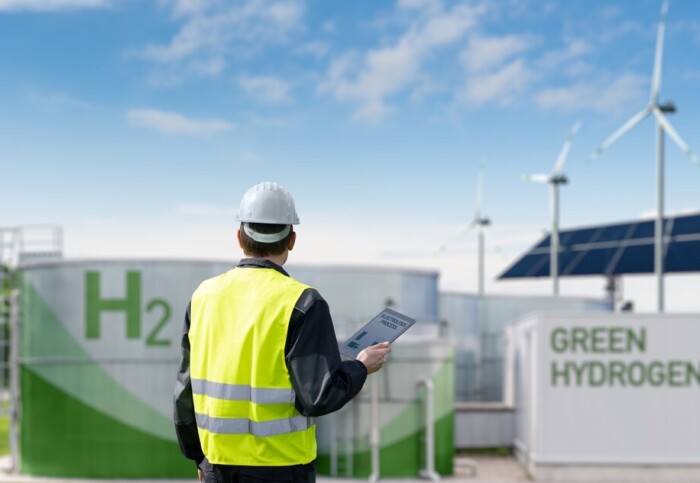New insights into catalysts could support transition to green hydrogen

New research published in Nature Catalysis could help design improved technologies for green hydrogen.
Green hydrogen could play a crucial role in reducing emissions and storing renewable energy, supporting the transition to a sustainable energy system and the UK’s goal of net zero by 2050.
It is produced by electrolysis, which involves splitting water into hydrogen and oxygen using electricity. Electrolysers are limited by the rate at which oxygen gas is produced—or ‘evolved’—and currently, only materials based on iridium can catalyse oxygen evolution at high enough rates for industrial state-of-the-art "polymer electrolyte membrane" (PEM) electrolysers. However, iridium is a scarce element, so scaling up this renewable technology is challenging.
Many researchers are now investigating ways to improve the rate of oxygen evolution, and minimise or completely eliminate iridium during electrolysis. A new study led by researchers at Imperial College London establishes the underlying mechanisms by which iridium-based materials work. This could eventually lead to new catalysts for electrolysis and enable the scale-up of green hydrogen.
Shining a light onto iridium-based catalysts
Until now, it has been difficult to compare the theoretical structures with the real-life materials used in electrolysers. Theoretical studies previously suggested that the rate of oxygen evolution is controlled by how certain molecules bind during a reaction. The ideal catalyst should strike a balance – it should bind not too weakly or too strongly. However, these calculations are based on idealised, perfectly flat crystalline structures in a vacuum, which do not capture how reactions happen naturally.

Researchers from Imperial College London have now developed a method to study the binding energies and reaction rates of iridium-based catalysts during water oxidation, using conditions that mimic real-life operation.
They achieved this feat by combining electrochemical experiments with optical spectroscopy. The experiment involved shining a beam of light through the sample and observing how the reactions taking place on the catalyst material change the colour of the light transmitting through the sample.
Caiwu Liang, a Postgraduate Research student in the Department of Materials, conducted the experiments. He explains, "We took advantage of a phenomenon known as electrochromism, whereby the catalysts change colour depending on their potential."
No one had precisely measured this colour change before. We collected enough quality data to produce a detailed picture of how the intermediates were driving the reaction. Dr Benjamin Moss Eric and Wendy Schmidt AI in Science Postdoctoral Fellow
Dr Benjamin Moss, a Research Fellow in the Department of Materials, built the setup. He adds, "No one had precisely measured this colour change before so that we could quantify the number of species participating in the reaction and the potential at which they formed.
By modernising the detection process and automating the experiment, we collected enough quality data to produce a detailed picture of how the intermediates were driving the reaction."
Professor James Durrant FRS from the Department of Chemistry pioneered these methods to study photocatalysts, which employ sunlight to drive the same water oxidation reaction. He highlights,
"We have been surprised and excited that our spectroscopic analyses can also provide new insight into materials that work in the dark, such as iridium oxide."
This new method of experimentally probing iridium-based catalysts also allowed researchers to measure the interaction between absorbates and their impact on reaction rates.

Dr Reshma Rao, a Lecturer at the Grantham Institute and Royal Academy of Engineering Research Fellow in the Department of Materials, co-supervised the research. She explains, “In particular, we were able to accurately measure how interactions between adsorbates influenced the reaction rates and compare them from one catalyst to another.”
Scientists from Copenhagen University used the findings at Imperial College London to refine their theoretical calculations. This allowed the team to build a new, modified model that considers the effect of interactions on trends in catalytic rates when comparing materials.
The next step
Professor Ifan Stephens, from the Department of Materials, supervised the experiments.
The next step will be even more exciting. Professor Ifan Stephens
He claims, "While we have revealed the factors controlling performance on two discrete catalysts, the next step will be even more exciting.
We aim to use this method to more broadly map out the factors in performance trends on a large number of materials and discover new catalysts with ultra-low or a complete absence of iridium."
Read the full paper in Nature Catalysis.
Main image credit: Shutterstock
Article text (excluding photos or graphics) © Imperial College London.
Photos and graphics subject to third party copyright used with permission or © Imperial College London.
Reporter
Kayleigh Brewer
Department of Materials
Prof. Ifan E. L. Stephens
Department of Materials